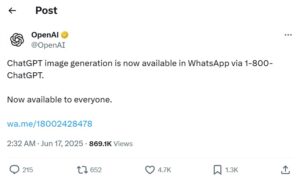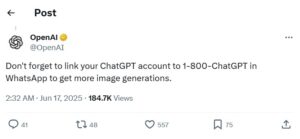Generative AI models like ChatGPT have revolutionized how we interact with web content and now with people as well. During a recent announcement, ChatGPT introduced its remarkable upgrade, allowing users to generate AI images on WhatsApp with ChatGPT. The feature enables individuals to communicate with their closest ones more effectively on the popular messaging app.
According to sources, generative AI holds a whopping user base of 115 to 180 million daily. It is not worth mentioning that in 2024, the overall genAI market valuation stood at $36 billion, and is likely to go beyond $442 billion by 2031. Such dynamics reflect the enhanced adoption of genAI in every aspect while simplifying tasks.
In this blog, we’ll discuss ChatGPT’s inclusion in WhatsApp for image generation and understanding generative AI’s evolution. Let’s get started…
The Announcement by OpenAI
WhatsApp now allows users to generate AI images with ChatGPT. ChatGPT’s image generation feature, powered by DALL-E, lets individuals create and generate desired images with just a prompt. All users need to do is access ChatGPT by saving its official number. The feature is available for all WhatsApp accounts and users.
OpenAI revealed on X, “ChatGPT image generation is now available in WhatsApp via 1-800-ChatGPT. Now available to everyone.”
Later, the firm also shared how to access and generate AI images on WhatsApp with ChatGPT.
How do we Generate AI Images on WhatsApp with ChatGPT?
Users are required to follow a few easy steps to create AI images on WhatsApp with ChatGPT. Here’s everything you need to do-
- Step 1: Firstly, save 1-800-ChatGPT (+1 800 242 8478), ChatGPT’s official number to the contact list of your device.
- Step 2: The next step is sending a ‘Hi’ message to the saved number on WhatsApp to start a conversation.
- Step 3: Before submitting a prompt, you can link your OpenAI account within the chat through a secure login page.
- Step 4: After getting logged in, share your detailed prompt, explaining the type of image you want to generate. An example of a prompt based on unrealistic imagination is “create an image of a cow on a boat sailing through a countryside river alongside its mates.”
- Step 5: Wait for a while until the time it generates the image. And here you go with your AI images on WhatsApp with ChatGPT.
Users can also access and start generating images on ChatGPT on WhatsApp by scanning the QR code available on the official website of OpenAI.
Why AI Image Generation on WhatsApp Matters?
Notably, WhatsApp has a user base of over 2 billion people worldwide. It has become a primary platform for chatting and calling. AI assistance, in this regard, can enhance the user experience while allowing for more impactful interaction. Below are the beneficial aspects of ChatGPT’s integration with WhatsApp-
Creativity at its Peak: The integration helps create fun images, memes, art, and graphical stories conveniently with just the right prompt. It fuels people’s creative side as well. The upgrade can also encourage realistic and unrealistic imagination while creating images.
Multi-purpose Usage: Since a diverse public uses WhatsApp regularly, ChatGPT image generation can address different tasks, including reports for students and compelling visuals for professionals.
Easy Access: Users can easily access ChatGPT’s image generation feature on WhatsApp without using any other application.
Multimodal Experience: The integration is backed by GPT-4o and DALL-E, so users can have a multimodal experience with text-based inputs and outputs in visual.
Evolution of Generative AI
Though generative AI came into public attention not before the 2020s, major breakthroughs in this genre occurred for decades. The evolution of generative AI and AI assistants has gradually progressed to become the impactful innovation we know today. The early stones were surely solidified by Joseph Weizenbaum, a computer scientist from MIT, with the development of the first text-based natural language processing software, ELIZA.
However, research and development in this area were enhanced with Nvidia’s launch of its graphical processing unit, GeoForce, in 1999. Tech giants like Google and Microsoft subsequently started researching generative models. The next breakthrough was marked by the arrival of the very first variational autoencoders (VAEs) in 2013. The first generative adversarial networks (GANs) were launched the following year. Gradually, research on large language models increased, and in 2018, OpenAI came up with one of the biggest advancements in the genAI revolution with the introduction of the Generative Pretrained Transformer (GPT) model.
GPT’s following upgrades included GPT-2, GPT-3, GPT-4o, GPT-4, and so on. In this journey, Google’s Bard, Meta’s LLaMA, and Anthropic’s Claude have also contributed. Subsequently, genAI received multimodal abilities that allowed these AI models to process input and offer output in text, voice, and vision, like images and videos.
Individuals and businesses started integrating these models to address critical tasks such as code, content, and graphics generation. As a result, genAI integration across industries, including messaging apps, has elevated. The most preferred messaging app, WhatsApp, also received integrations with MetaAI and ChatGPT, which work as personal messaging assistants for users.
What the Future Holds?
Alongside ChatGPT, Meta AI is also available on WhatsApp, which works as an AI assistant to users, helping them communicate effectively. Surprisingly, people are using these features increasingly, considering them helpful. Therefore, we can observe how generative AI models are becoming remarkably common today.
Evidently, the future can experience enhanced integration of generative AI beyond messaging applications. So, brace yourselves for the tech-driven tomorrow, where AI assistants will become more accessible and available for people.
Follow HiTechNectar’s blog update and stay aligned with the knowledge curve!
F&Qs
Q1. Can WhatsApp create AI images?
Answer: Yes, WhatsApp can help you create AI images. All users have to do is use the right prompt on Meta AI and ChatGPT, suggesting the AI bot create an image that meets their expectations.
Q2. Does WhatsApp AI use ChatGPT?
Answer: OpenAI’s ChatGPT is accessible through WhatsApp chat. Users can insert their text, voice, and image input into ChatGPT to get outcomes. You can enable the chatbot by saving 1-800-ChatGPT to your contact list.
Q3. How to create an AI DP for WhatsApp?
Answer: Users can utilize WhatsApp’s Meta AI to create an AI DP. Access the Meta AI tab on the messaging app, add a descriptive prompt about your DP, and easily generate images as you like.
You may like:
AI Chibi Figures Trend: Create Your Own AI Chibi Avatar with ChatGPT
OpenAI Introduces GPT-4o, a Faster and Free Model for all ChatGPT Users
How to Create Free Ghibli-Style AI Images & Animated Videos Using ChatGPT, Grok-3, and Gemini?




